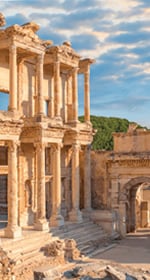|
    
|
|
 |

Follow in the Footsteps of St. Paul Pilgrimages
Also known as Paul the Apostle, St. Paul is one of the greatest writers and teachers of God's word in the history of Christianity. The Irony is, he used to persecute Christians. St. Paul was called Saul or Sh'aul, and was born to Roman Parents in Tarsus town Cicilia. He attended Bible School in Jerusalem from an early age, then studied under a famous rabbi, and became an expert of the law. St. Paul became famous and he worked with the Jewish authorities who had him actively pursue and persecute members of a news sect that confessed Jesus Christ of Nazareth was the messiah. The sect also proclaimed that God's kingdom was at hand. It is on one such trip to persecute this sect on the road to Damascus that St. Paul had a supernatural encounter and was converted to the same Christian sect he was persecuting! Paul was struck blind and was to fast for three days. He regained his sight after a Christian, Ananias prayed for him. He then got baptized. St. Paul is credited with writing 13 out of the 27 books in the New Testament.
Follow in the Footsteps of St. Paul Programme
- Pilgrimages following the footsteps of Saint Paul offer a profound journey through various significant locations associated with his life and missionary travels. These destinations major spiritual significance for all Christians seeking to trace the footsteps of this influential apostle. Here are some of the key places of pilgrimage linked to Saint Paul:
-
Tarsus, Turkey: Tarsus is recognized as the birthplace of Saint Paul. Pilgrims visit this ancient city to explore sites related to his early life. The city boasts historical remnants, including the Cleopatra's Gate and remnants of Roman architecture, providing insights into the environment where Paul grew up.
-
Antioch, Turkey: Antioch served as a crucial hub for Saint Paul's missionary journeys and where he embarked on his first significant mission. Pilgrims visit this site to discover remnants of ancient Antioch and to reflect on Paul's early evangelistic endeavors.
-
Ephesus, Turkey: Ephesus was a significant city for Saint Paul, where he spent several years preaching and establishing a Christian community. Pilgrims explore the well-preserved ruins of Ephesus, such as the Library of Celsus and the Great Theater, imagining Paul's teachings amid these ancient structures.
-
Corinth, Greece: Corinth was another crucial location in Saint Paul's ministry. Pilgrims visit the ruins of ancient Corinth to witness the Bema (judgment seat) where Paul appeared before the Roman governor Gallio and to contemplate his letters to the Corinthians while exploring the archaeological remains.
-
Philippi, Greece: Saint Paul visited Philippi, which became an essential Christian community. Pilgrims explore the archaeological site of Philippi, including the Baptismal Site of Lydia, reflecting on Paul's teachings and his letter to the Philippians.
-
Malta: The island of Malta is renowned in Christian history for Saint Paul's shipwreck around 60 AD. Pilgrims visit St. Paul's Bay, believed to be the location of the shipwreck, and the grotto of St. Paul, where tradition holds that Paul took refuge after the shipwreck. The Church of St. Paul's Shipwreck in Valletta commemorates this event and is a significant pilgrimage site. Pilgrims reflect on Paul's resilience, faith, and his mission despite the challenges he faced during his time on Malta. The inclusion of Malta in the footsteps of Saint Paul's pilgrimage allows pilgrims to contemplate Paul's perseverance in spreading the Christian message despite adversity. Exploring the sites associated with his time on the island offers a unique perspective on his journey and reinforces the historical and spiritual significance of Malta in the narrative of early Christianity.
-
These places of pilgrimage offer opportunities for spiritual reflection, historical exploration, and cultural immersion. Pilgrims can experience a profound connection to Saint Paul's life, teachings, and the early Christian communities while traversing these historically rich destinations. Guided tours, religious services, and personal reflection at these sites allow pilgrims to deepen their understanding of Saint Paul's impactful journey in spreading the Christian faith.
DATES
& PRICES IN FOLLOW IN THE FOOTSTEPS OF ST. PAUL
|



